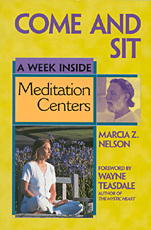In his foreword to this edifying nonsectarian guide to meditation practice in seven religious traditions, Wayne Teasdale writes: "There is considerable evidence everywhere we look that we have entered a new age — not in the sense of the "New Age movement," but in the sense of a radically novel period of history. . . . This new age can be characterized as essentially interspiritual, since its measures the breakdown of barriers separating the religions as more and more people cross boundaries to explore the treasures of the various traditions. The Interspiritual Age is one in which people are interested more in mystical spirituality, and less in religion. Mysticism is direct awareness and experience of Ultimate Reality, the Divine Mystery, God, or the Infinite Spirit. It is the commitment to a mystical experiential path that sets off the Interspiritual Age from all other ages."
Marcia Z. Nelson is a very good writer for the Interspiritual Age. She is a meditator, freelance journalist, teacher, and author of The God of Second Chances: Stories of Lives Transformed by Faith. In this well-done work, she answers questions that might be on the mind of anyone interested in meditation such as: Why do people do this? What kinds of meditation are there? How do the various religions differ in their approach to this devotional practice? Where should I start?
Nelson defines meditation as exploration of the real nature of mind, body, spirit, world — in other words, as "inner research." Across traditions, this practice involves attention, the breath, and greater awareness of the present moment. In the first chapter, the author examines centering prayer which, in the words of Father Thomas Keating, is an experience of the presence of the Holy One: "You don't have to do anything. Just rest in God's arms. It is an exercise in being rather than doing." Nelson presents the four steps of centering prayer and lists books, centers and organizations that provide more resources.
Other meditation practices covered in this paperback are Zen Buddhist meditation (true emptiness), Insight Meditation (being mindful), Tibetan Buddhist meditation (diamond clarity), Hindu meditation (that thou art), Sufi meditation (remembering the Beloved), and Jewish meditation (awakening to tradition). Clear explanations, comments from practitioners on their experiences with each type of meditation, and steps for beginners at the end of the chapters make this a very helpful resource.
